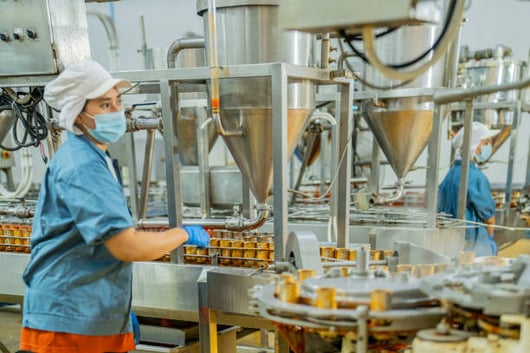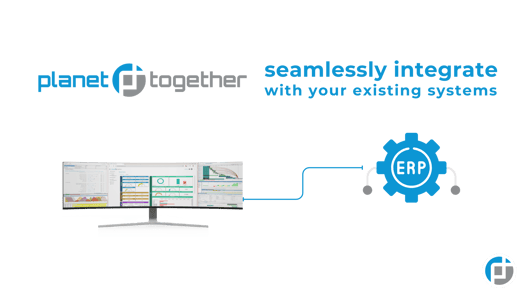
Accelerating Reshoring in Food and Beverage Manufacturing: The Strategic Role of Advanced Planning and Scheduling
The global food and beverage (F&B) industry has long relied on international supply chains for ingredients, packaging materials, and even manufacturing capabilities. However, recent events—ranging from pandemic disruptions and geopolitical instability to increasing freight costs and consumer demand for local sourcing—have accelerated the reshoring movement. For Production Planners, this shift introduces a new strategic imperative: how to realign production operations swiftly and efficiently to meet reshoring goals without compromising profitability, quality, or speed-to-market.
In this context, advanced planning and scheduling (APS) solutions like PlanetTogether, especially when integrated with leading enterprise systems such as SAP, Oracle, Microsoft, Kinaxis, or Aveva, are becoming essential tools for navigating the complexity of reshoring in F&B manufacturing.
The Reshoring Imperative in Food and Beverage
Reshoring refers to bringing manufacturing and supply operations back to domestic or nearby facilities. For the food and beverage sector, reshoring is about more than national pride—it’s about resilience, agility, sustainability, and consumer trust. The drivers behind reshoring include:
Supply chain vulnerabilities: Long lead times, bottlenecks at ports, and unreliable overseas suppliers threaten on-time delivery.
Rising transportation costs: Fuel prices and logistical complexities increase total landed costs.
Consumer preference for local: Shoppers are gravitating toward locally produced goods for reasons of freshness, sustainability, and transparency.
Regulatory alignment: Domestic production often simplifies compliance with food safety standards.
Yet, reshoring is not simply a matter of moving machines or sourcing domestically—it demands strategic reconfiguration of production planning, requiring new operational workflows and scheduling precision.
The Planner's Challenge: Reshoring Without Disrupting Production
For a Production Planner, the decision to reshore or nearshore production introduces several layers of complexity:
Realigning capacity: Moving production means recalibrating available labor, equipment, and shift schedules at new or existing local plants.
Adjusting procurement: Ingredients or packaging previously sourced internationally must now be found locally, often with different lead times and quality specifications.
Inventory risk management: Production schedules must account for supply gaps during the transition phase.
Coordinating multiple systems: Reshoring often requires seamless communication between planning systems, MES, and ERP platforms.
To manage these dynamics effectively, Production Planners need an integrated, intelligent solution capable of aligning reshoring goals with plant-level execution.

How APS Tools Like PlanetTogether Help Accelerate Reshoring
PlanetTogether APS, when integrated with ERP systems such as SAP, Oracle, Microsoft Dynamics, Kinaxis, or Aveva, provides a synchronized, agile planning environment. Here’s how it supports reshoring strategies:
Real-Time Visibility and What-If Scenario Modeling
Reshoring decisions often hinge on evaluating multiple “what-if” scenarios: What happens if we consolidate production in a regional hub? What’s the impact of a 10-day delay in a local ingredient supplier?
PlanetTogether enables planners to simulate these options and compare outcomes in terms of cost, efficiency, lead time, and utilization. Integrated with SAP or Oracle, it pulls in real-time inventory and resource data to ensure simulations reflect actual constraints.
Dynamic Resource Allocation
Domestic production may involve smaller facilities with less automation than offshore mega-plants. With APS, planners can dynamically adjust capacity, manage changeovers, and schedule batch sizes to optimize limited resources—especially critical in high-variation F&B environments.
Integration with Aveva MES allows for real-time machine status feedback, enabling truly responsive production scheduling.
Supplier Synchronization and Order Promising
Moving to domestic suppliers means recalibrating lead times, order cycles, and material availability. With Kinaxis or Microsoft Dynamics integration, PlanetTogether gives planners upstream visibility into supplier timelines, enabling more accurate order promising and procurement alignment.
Minimizing Waste and Maximizing Freshness
The F&B industry has little room for error due to perishability. Reshoring must not lead to excessive waste or production redundancy. PlanetTogether’s expiration-aware scheduling ensures that batches are produced and delivered within optimal shelf-life windows, even as sourcing and production locations change.
Planning for Reshoring Success: Best Practices
As more F&B manufacturers pursue reshoring, Production Planners can lead the charge by adopting several best practices:
Standardize Planning Across Plants
Use PlanetTogether to develop a centralized planning model that accounts for resource variability across domestic and international sites. This makes transitions smoother and scalable.
Use APS for Capacity Smoothing
Leverage scheduling algorithms that balance workloads across multiple lines, shifts, or even nearby plants. Capacity smoothing prevents overloading newly reshored lines and ensures labor efficiency.
Integrate with ERP Early
Whether you're using Microsoft Dynamics for procurement, SAP for inventory, or Oracle for demand planning, early integration with APS ensures that all decisions are made with full data visibility.
Prioritize Agile BOM Management
Local ingredient availability may necessitate recipe adjustments. Use PlanetTogether in tandem with ERP systems to plan for alternate BOMs that reflect local sourcing without production delays.
Measure, Learn, and Iterate
Reshoring is a journey. Use PlanetTogether’s reporting and KPI dashboards to monitor progress—production cycle time, order fill rate, supplier reliability—and iterate on planning strategies accordingly.
Reshoring isn’t just a supply chain decision—it’s a planning challenge with enormous implications for cost, quality, and customer satisfaction. For Production Planners in the food and beverage sector, reshoring presents an opportunity to build more resilient, responsive, and sustainable operations.
By leveraging advanced APS tools like PlanetTogether, integrated with systems such as SAP, Oracle, Microsoft, Kinaxis, or Aveva, planners can move beyond reactive scheduling and take a proactive role in reshaping the future of their manufacturing networks.
In a world where local is becoming the new global, strategic production planning is the key to staying competitive. Are you ready to take your manufacturing operations to the next level? Contact us today to learn more about how PlanetTogether can help you achieve your goals and drive success in your industry.

